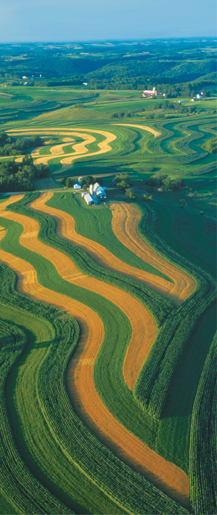Soil Use and Sustainability  It is possible to minimize soil erosion through careful management of both agriculture and forestry. Soil is most vulnerable to erosion when it is completely bare. Leaving stems and roots of the previous year's crop in the soil can help hold soil in place between plantings. And because different plants take different nutrients from the soil, crop rotation—planting different crops at different seasons or in different years—can help prevent both erosion and nutrient loss.
It is possible to minimize soil erosion through careful management of both agriculture and forestry. Soil is most vulnerable to erosion when it is completely bare. Leaving stems and roots of the previous year's crop in the soil can help hold soil in place between plantings. And because different plants take different nutrients from the soil, crop rotation—planting different crops at different seasons or in different years—can help prevent both erosion and nutrient loss.
Altering the shape of the land is another way to limit erosion. The practice of contour plowing, shown in Figure 6–7, involves planting fields of crops across, instead of down, the slope of the land. This can reduce water runoff and therefore erosion. Similarly, terracing—shaping the land to create level “steps”—helps hold water and soil.
What are options for sustainable forestry? Selectively harvesting mature trees can promote the growth of younger trees and preserve the forest ecosystem, including its soil. In the southeastern United States, conditions enable foresters to plant, harvest, and replant tree farms. A well-managed tree farm both protects the soil and makes the trees themselves a renewable resource.

FIGURE 6–7 Contour Plowing Planting crops parallel to the land's natural contours can help reduce soil erosion.
Freshwater Resources
 What are the primary sources of water pollution?
What are the primary sources of water pollution?
Humans depend on fresh water and freshwater ecosystems for goods and services, including drinking water, industry, transportation, energy, and waste disposal. Some of the most productive American farmland relies heavily on irrigation, in which fresh water is brought in from other sources.
While fresh water is usually considered a renewable resource, some sources of fresh water are not renewable. The Ogallala aquifer, for example, spans eight states from South Dakota to Texas. The aquifer took more than a million years to collect and is not replenished by rainfall today. So much water is being pumped out of the Ogallala that it is expected to run dry in 20 to 40 years. In many places, freshwater supplies are limited. Only 3 percent of Earth's water is fresh water—and most of that is locked in ice at the poles. Since we can't infinitely expand our use of a finite resource, we must protect the ecosystems that collect and purify fresh water.
Water Pollution Freshwater sources can be affected by different kinds of pollution. A pollutant is a harmful material that can enter the biosphere. Sometimes pollutants enter water supplies from a single source—a factory or an oil spill, for example. This is called point source pollution. Often, however, pollutants enter water supplies from many smaller sources—the grease and oil washed off streets by rain or the chemicals released into the air by factories and automobiles. These pollutants are called nonpoint sources.
Table of Contents
- Formulas and Equations
- Applying Formulas and Equations
- Mean, Median, and Mode
- Estimation
- Using Measurements in Calculations
- Effects of Measurement Errors
- Accuracy
- Precision
- Comparing Accuracy and Precision
- Significant Figures
- Calculating With Significant Figures
- Scientific Notation
- Calculating With Scientific Notation
- Dimensional Analysis
- Applying Dimensional Analysis




